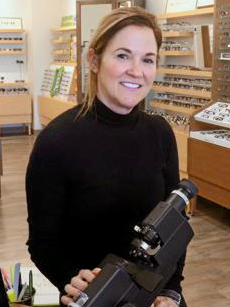|
|
|
|
|
|
Tap Into the Topical News
|
|
|
|
From the SNAPP Board
When big news about eye care hits the airwaves, patients and customers take notice. Some of you may have recently fielded questions from patients who heard about the fines levied against Hubble Contacts or they have heard that February is Age-Related Macular Degeneration (AMD) Awareness Month.
|
|
|
|
|
Are these news stories encouraging patients to ask questions? Or are you using them to spur conversation with patients? News events and awareness months are great opportunities for education.
To jumpstart your conversation, here are some AMD facts that everyone involved in an eye care business can share.
• AMD is the leading cause of blindness among older Americans.
• Early detection is key.
• There are new treatments that make the disease more manageable than ever before.
Similarly, here are some talking points around contact lens prescriptions.
• Optometrists select contact lenses for an individual based on a variety of factors, including design, materials and wearing schedule.
• Not all contact lenses, even when they have the same prescription, are alike—because of the factors above.
• Your eye health is important to us, and staying with the prescribed brand and following the cleaning and replacement measures are the best ways to ensure long-term comfort and vision.
How do you squeeze moments of patient education into your day? Share your ideas here.
|
|
|
SNAPP Member Perspectives |
|
|
|
|
|
|
|
Travis Lehr, OD, FAAO, knows that the past two years have held challenges for a number of eye care practices, but his professional services sublease in Sioux Falls, South Dakota, and the Pearle Vision location next door both had year-over-year growth in 2020 and 2021. Dr. Lehr says that serving patients’ complete eye care needs was a factor that helped both the professional services side and the retail side achieve two record years.

Dr. Lehr
Do more for patients
Dr. Lehr completed a residency in ocular disease and surgical management. During his residency, he saw no routine eye exams, so that was a bit of an adjustment when he started practicing in Sioux Falls. “I had almost forgotten that there were ‘normal’ eyes,” he says, joking. But the experience also has helped him manage a wide range of conditions. He can monitor and treat his patients who have glaucoma and age-related macular degeneration, and he has an excellent referral relationship with ophthalmologists in the region.
During the pandemic, people appreciated not having to travel far or spend hours in an unfamiliar practice to be seen briefly by a specialist. Dr. Lehr added Optos ultra-widefield imaging technology, which adds to his clinical data and his ability to educate patients as well as enables him to provide doctors to whom he is referring high-quality documentation. This investment was extremely worthwhile because it aided his mission of being able to do more for patients and has created a high level of loyalty. “We use this image as an educational tool displayed on a 42-inch TV in the exam room to discuss how their systemic health can show problems in their retina,” says Dr. Lehr.
Changing demographics
His region may have benefited from the migration of people who left their expensive homes in urban areas on the East and West coasts and resettled in the middle of the country. “The cost of living is lower here, so for some people, it freed up the ability to take care of their medical needs and eyewear purchases,” he says.
In addition, as the area’s population grew and people found jobs, these employees may have become more aware of the medical and vision benefits their employer provides, he says. Dr. Lehr became credentialed with as many medical and vision plans as he could because patients often seek an in-network provider. A number of employers have made their benefits plans more generous, with features such as contributing to the flex spending accounts, so patients want to use those benefits.
Continue investing
To improve efficiency, Dr. Lehr is now looking at training some of his staff to serve as scribes. During his time practicing in an OD/MD setting, every eye care professional worked with scribes—and Dr. Lehr believes it can work well in this setting, too. “Doctors who have an effective scribe do not get bogged down in trying to be the person who is documenting and the person who is educating. A good scribe who stays with the patient can also serve as an extension of the doctor’s messaging, reinforcing information about dry eye, for example,” he says.
“Change the narrative”
Dr. Lehr says that one of his goals has been to “change the narrative. I don’t want people to think of Pearle Vision as the place they come for their eyewear and contact lenses. I want them to think of this as the place they come for all their eye care needs.” Doing so has helped all parts of this Pearle location to thrive.
|
|
|
Staff Is the Backbone of Successful Practice Management |
|
|
|
Lori Edwards, Licensed Operator (LO), is a veteran in the field, having more than 20 years of experience. She began as a marketing director for a large ophthalmology group and then as an account manager for a wholesale optical laboratory, until she felt ready to take on a new challenge. Having a strong desire to be self-employed, she says that becoming a Pearle Vision LO was a perfect decision. “I wanted to take the lead and make my own decisions but also wanted to minimize the risk of a start-up venture. Being a Pearle Vision LO allowed me to manage the business but also be part of a well-respected national brand such as Pearle,” she says. Edwards opened her first location six years ago in Longmont, Colorado, and opened a second location nearby in Loveland, Colorado.

Lori Edwards
Sticking to core values
Both locations are top performers in the region, and the secret sauce to her success is her amazing team, Edwards says. “When everyone is trained to be accountable for the practices’ core values and to consider the effects their actions have on the team and the business, work quality and the desire to accomplish goals increase,” she says. “They work together toward team goals but also have opportunity to hit individual goals.”
Beginning this year, Edwards is incorporating the core values into each staff’s annual performance review as well as peer-to-peer evaluations. The slogan “BE PEARLE” encompasses several traits, such as gratitude, self-improvement, teamwork, customer-centered service, accountability and executional excellence. “I want my customers to feel like their concerns are being recognized and taken care of, rather than emphasizing product selling. I want my staff to first develop relationships through listening and offer solutions based on needs,” she says. “The sale is simply the end result of properly meeting their needs.”
The emphasis on core values has been effective; on a daily basis, she witnesses her staff members going out of their way to make customers feel at home and valued. For example, when some people felt uncomfortable walking into the office due to the coronavirus, her staff began offering curbside pick-up services.
Together, everyone achieves more
“Fostering a team environment is important for creating a place where everyone encourages each other’s growth and hears each other’s concerns,” she says.
Alongside the annual performance reviews, Edwards also hosts team-building activities several times a year. “My staff loves these, and I absolutely love seeing everyone cut loose a little and have a great time,” she says. She also arranges monthly huddles to discuss the things they are doing well, the things they need to work on and new things to implement for the continued growth of the stores.
“We strive to be the best possible versions of ourselves; we want to ‘BE PEARLE,’” Edwards says.
|
|
|
|
|
|
|
SnappGroupMasterminds to Launch in June at Optometry’s Meeting |
|
|
|
SNAPP is creating SnappGroupMasterminds, with its inaugural 2022 class of up to 20 charter members.
Program highlights: There will be one in-person and two virtual, confidential meetings with fellow SnappGroupMasterminds members. These meetings and participants will challenge your assumptions and find out what is limiting your success. You will gain a diversity of perspectives from those who have faced and overcome similar challenges.
Optimize: With the support of SnappGroupMasterminds, you will work toward one common goal—to make better decisions to benefit your business.
Connect: From your fellow SnappGroupMasterminds members, you will obtain as much unbiased feedback as possible on your business challenges.
For more information on this amazing opportunity, contact Deni Hall here.
|
|
|
Billing Tip of the Month from VisionWeb |
|
|
|
|
Start the Year off Strong With These Billing Tips
|
|
|
|
By Amanda Whitener, Revenue Cycle Management Team at VisionWeb
|
|
|
|
|
|
|
We’re already weeks into the new year. It’s likely your practice was significantly busy in December. But as the saying goes, “You make hay while the sun shines.”
Now, with the new year, insurance benefits are renewing, and wallets are full of FSA $. These are great problems to have, but they are problems, nonetheless. The upside is that there should be another influx of cash in the very near future from all the insurance payments that are outstanding.
This year has been very challenging as many practices have been met with severe staffing shortages. It can be tough to find the time to work on the practice rather than solely in the practice. So how do ODs stay knowledgeable to ensure their cash is moving in the right direction and claims aren’t piling up?
Below you will see three basic steps that should take no longer than about 15 minutes to confirm claims and cash are moving in the right direction.
1. Check your practice management system to ensure all patients are checked out and subsequently billed.
• It’s so simple we shouldn’t even have to say it, but year after year we get new revenue cycle management (RCM) clients who have unpaid claims simply because the claims weren’t submitted! Have you ever asked a friend for help with a product only to find the product wasn’t plugged in, turned on, etc.? Imagine that feeling when you realize you didn’t get paid because your staff member never even submitted your claims.
2. Check on outstanding rejections/denials.
• You may be thinking, “That takes way more time than 15 minutes!” Note that we are talking about transparency and oversight, not the actual resubmission. All Pearle practices get a TriZetto account. This should allow you to take a quick look at what your biller is doing or, more importantly, not doing.
• Be familiar with your payors’ timely appeal limits since they can vary by payor. Make sure your biller is well-versed in these limits as well.
3. Run an aging report regularly to see what balances are still outstanding.
• Most practices consider a low AR over 90 percentage to be a success, but be wary of inappropriate write-offs. Spot check what your biller has written off to verify that they are not losing money for the practice. There should be an adjustment report in your practice management system that will give you additional transparency. A little oversight goes a long way!
Getting in a habit of doing these three things at least once a week can help provide not only a better understanding of the status of claims but also maximizes and recognizes additional cash.
Reach out to Amanda with any other billing questions you have here; she might have the solution for you.
|
|
|
|
|
|
|
Should COVID-19 Policies Be in the Handbook? |
|
|
|
Should we have a COVID-19 section in our employee handbook?
|
|
|
|
|
Here’s an answer from the HR Pros at AmCheck Las Vegas
While COVID-19 will continue to affect our workplaces for some time, we generally recommend not adding COVID-19 policies directly to your handbook.
|
|
|
|
|
Guidance from the Centers for Disease Control and Prevention continues to evolve, and federal and state laws related to the pandemic will continue to change as well. And as we’ve seen with OSHA’s Emergency Temporary Standard, courts can put employer obligations on hold (or resume their effective date) unexpectedly.
Instead of making changes directly to your employee handbook, we recommend incorporating COVID-19-related policy updates into a separate handbook addendum, or just a packet of policies and documents that each employee will receive. This is likely to be easier to maintain administratively and should also cut down on how much time employees spend looking for COVID-19-related policies when they need them. Keeping these policies separate also underscores that they are temporary and will be removed at the appropriate time.
Policies in a COVID-19 addendum or policy kit may include a work-from-home policy, face-covering policy, workplace safety rules, vaccination policy, workplace sanitation procedures and internal policy changes related to the pandemic (e.g., travel, paid time off and call-in procedure).
If you want to have a general policy related to illness that details when to stay home, whom to notify of an illness, etc., you could include that directly in the employee handbook. Just make sure that the policies there align with whatever you have included in your COVID-19 addendum if you have one.
|
|
|
|
|
Hubble Contacts Settles $3.5 Million Penalty to FTC
|
|
|
|
The Federal Trade Commission (FTC) has reached a $3.5 million settlement with Vision Path Inc., the parent company of Hubble Contacts, which is the largest amount ever for a matter involving violations of the Contact Lens Rule.
|
|
|
|
|
Hubble Contacts violated the rule in several ways: failing to obtain prescriptions, not properly verifying prescription information, substituting Hubble lenses for those actually prescribed to consumers and failing to disclose that many reviews of Hubble lenses were written by reviewers who were compensated for their statements. Read more here.
|
|
|
Get Your Free N95 Masks and Test Kits
|
|
|
|
Consumers are able to pick up their free N95 masks at grocery stores and pharmacies. The Biden administration provided 400 million N95 masks from the Strategic National Stockpile, and each person can receive up to three free masks, if available.
|
|
|
|
|
Businesses such as Meijer, Kroger, Walgreens, Walmart, CVS Pharmacy, Rite Aid and more have received and begun distributing masks. Read more here. People can also order free test kits here.
|
|
|
AI System Analyzes Eye Scans to Identify Patients at a High Risk of a Heart Attack |
|
|
|
University of Leeds scientists developed an artificial intelligence (AI) system that can analyze retinal eye scans taken during a routine visit and identify patients at a high risk of a heart attack. Doctors recognized that tiny blood vessels in the retina are indicators of broader vascular disease, including heart attacks.
|
|
|
|
|
The AI system had an accuracy between 70 percent and 80 percent and could be used as a second referral mechanism, researchers said. Read more here.
|
|
|
World Council of Optometry and CooperVision Releases A Practical Guide to Managing Children With Myopia |
|
|
|
The World Council of Optometry (WCO) and CooperVision partnered to release a professional article, A Practical Guide to Managing Children With Myopia, authored by four ocular health and science professionals across the world.
|
|
|
|
|
The article shares insight on what the WCO Standard of Care entails and how eye care professionals can incorporate it. Read more here.
|
|
|
Pfizer Applies to the FDA to Request Emergency Use Authorization for Children Under 5 |
|
|
|
Pfizer and BioNTech requested emergency use authorization for a two-dose vaccine for children between 6 months and 5 years old. Testing has been ongoing for several months, and in December, an analysis showed that a two-dose vaccine created an immune response for children between the ages of 6 months and 2 years.
|
|
|
|
|
The data on a third dose will not be available until March 2022. Read more here.
|
|
|
|
Getty Images photo credits—penalty: Zolnierek; and child: JBryson
|
|
|
|
|
|
|






